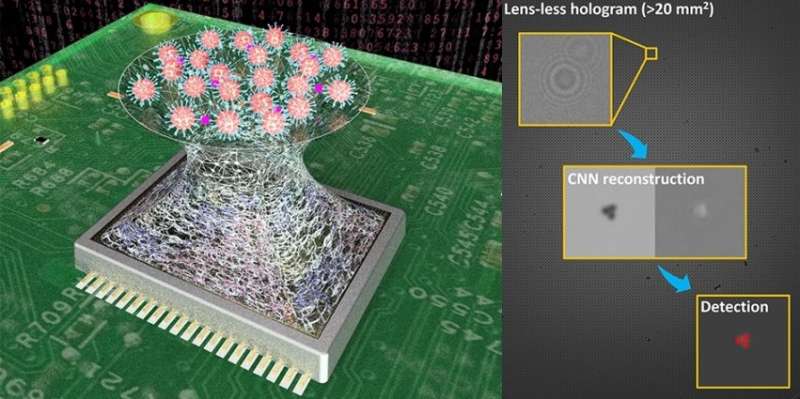Artificial intelligence detects the presence of viruses

Many biosensing applications rely on characterization of specific analytes such as proteins, viruses and bacteria, among many other targets, which can be accomplished by using micro- or nano-scale particles. In such biosensors, these particles are coated with a surface chemistry that makes them stick to the target analyte forming clusters in response. The higher the target analyte concentration is, the larger the number of clusters gets. Therefore, monitoring and characterizing these particle clusters can tell us if the target analyte is present in a sample and in what concentration. Current methods to perform such an analysis are limited in that they are either capable of only a coarse readout or rely on expensive and bulky microscopes, which limit their applicability to address different biosensing needs, especially in resource limited environments.
To overcome the shortcomings of the existing solutions, UCLA researchers have developed a rapid and automated biosensing method based on holography coupled with deep learning – currently, one of the most promising and successfully used methods in artificial intelligence, AI. In this system, all the particle clusters and individual micro-particles in a sample are first imaged in 3-D as holograms, all at the same time, and over a very large sample area of more than 20 mm2, more than ten-fold larger than the imaging area of a standard optical microscope. Next, a trained deep neural network processes these holograms and rapidly reconstructs them into images of clusters similar to those that could be obtained with a standard scanning microscope, but doing this much faster and for a significantly larger sample volume. During this process, all the particle clusters at the micro-scale (revealing the presence of the target analyte) are automatically counted with a sensitivity similar to a laboratory-grade microscope.
As a proof of concept, UCLA researchers successfully demonstrated the application of this deep learning-based biosensing approach to detect herpes simplex virus (HSV) and achieved a detection limit of ~ 5 viruses per micro-liter, providing a clinically relevant level of sensitivity for HSV detection. HSV is one of the most widespread viral infections that is estimated to have affected more than 50% of the adults in the US.
This work was published as a cover article in ACS Photonics, a journal of the American Chemical Society. The research was led by Dr. Aydogan Ozcan, an associate director of the California NanoSystems Institute (CNSI) and the Chancellor's Professor of electrical and computer engineering at the UCLA Henry Samueli School of Engineering and Applied Science, along with Yichen Wu, a graduate student, and Aniruddha Ray, a postdoctoral scholar, at the UCLA electrical and computer engineering department.
"Our work demonstrates an automated, inexpensive platform for rapid read-out and quantification of a wide variety of particle clustering-based biosensors. This unique capability enabled by deep learning will help democratize biosensing instrumentation, making them suitable for wide-scale use even in developing countries," said Ozcan.
More information: Yichen Wu et al. Deep Learning Enables High-Throughput Analysis of Particle-Aggregation-Based Biosensors Imaged Using Holography, ACS Photonics (2018). DOI: 10.1021/acsphotonics.8b01479
Journal information: ACS Photonics





















